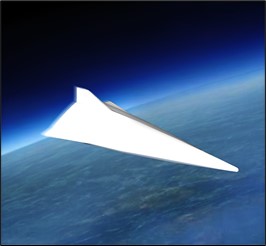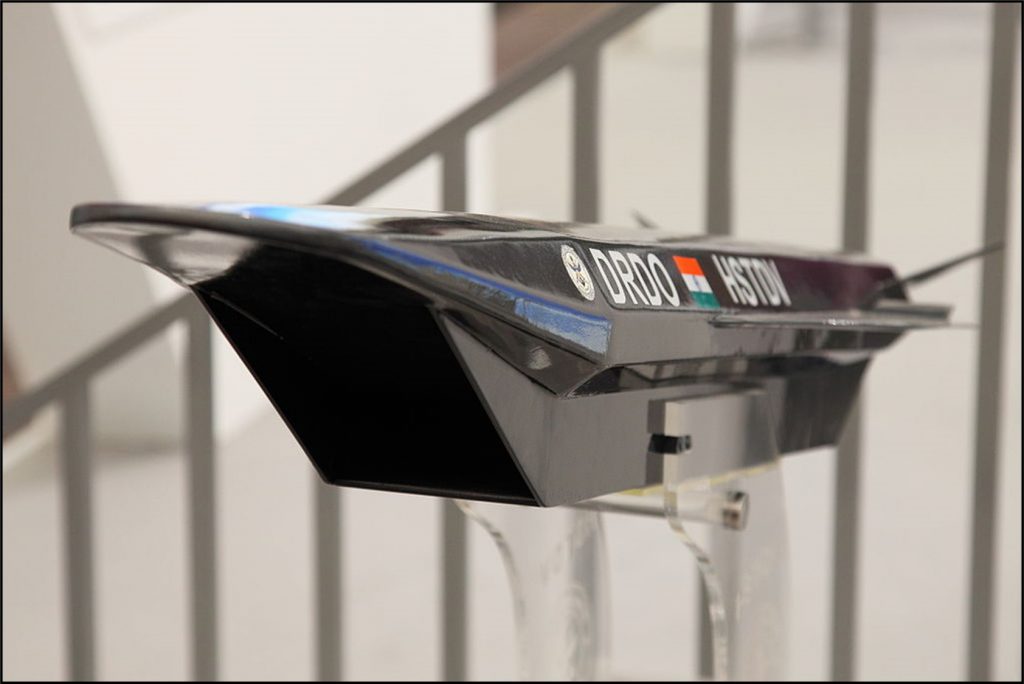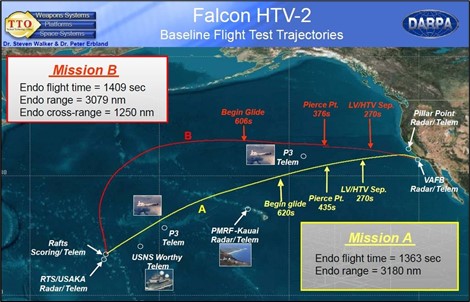The Defense Systems Information Analysis Center (DSIAC) received a technical inquiry requesting information on the status of hypersonic missile technology and asked if the technology uses any organic composite materials. DSIAC materials engineering subject matter experts briefly summarized the different types of hypersonic systems and then provided an overview of the current hypersonic missile technologies from China, Russia, India, and the United States. Finally, a discussion on the use of organic composite materials is provided, stating that they are most likely not used for external components of hypersonic systems but may have use for internal component materials.
1.0 Introduction
The inquiry stemmed from the New York Times article “Hypersonic Missiles Are Unstoppable. And They’re Starting a New Global Arms Race” [1].
The Defense Systems Information Analysis Center (DSIAC) received support from Mr. Doyle T. Motes, P.E., who is a subject matter expert (SME) in materials science and engineering from Texas Research Institute (TRI) Austin. To respond to the inquiry, Mr. Motes performed literature searches using open sources, the Defense Technical Information Center (DTIC) Research and Engineering (R&E) Gateway, National Aeronautics and Space Administration (NASA) publications, university library resources, and conference notes.
2.0 Different Types of Hypersonic Systems
Hypersonic vehicles have been designed and operated since World War II (WWII) (e.g., the V-2 rocket, developed during WWII, reached maximum speeds in excess of Mach 10) and the beginning of the space race when the United States and Russia tried to recover satellites and capsules falling back to Earth at reentry speeds in excess of Mach 25.
Hypersonic vehicles are categorized as follows, depending on their mission [2]:
- Manned Aircraft
- The first and only example of this aircraft is the U.S. North American X-15, which set the world airspeed record of Mach 6.72 in 1967.
- Unmanned Vehicles
- These vehicles are mainly experimental projects, such as the Boeing X-43, which reached Mach 9.6 in 2004.
- Scramjet-Powered Hypersonic Missiles
- An example of this missile is the Russian 3M22 Zircon.
- Hypersonic Glide Vehicles
- Examples of these vehicles include the Russian Avangard or the U.S. Advanced Hypersonic Weapon (AHW).
- Air- or Ground-Launched Space Vehicles
- Examples of these vehicles include the Soviet Buran, U.S. Space Shuttle Orbiter vehicles, the Dragon space capsule, or reentry bodies for intercontinental ballistic missiles (ICBMs), which reach speeds of Mach 25 upon reentry.
There are three types of military hypersonic vehicles [2]:
- Reconnaissance Vehicles
- Examples of these vehicles include the Lockheed Martin SR-72, which is supposedly capable of 7,400 kph.
- Hypersonic Kill Vehicles
- Examples of these vehicles include the Russian 3M22 Zircon or the U.S. X-51A Waverider.
- Hypersonic Interceptors
- These inceptors are designed to intercept ballistic missile warheads. Examples include U.S. RIM-161 SM-3 Block IIA missiles.
This report focuses on powered hypersonic missiles and hypersonic glide vehicles, which are both capable of advanced maneuvers to reach their intended targets.
The two realms of hypersonic speeds commonly explored with today’s developing technology are hypersonic (Mach 5–10) and high hypersonic (Mach 10–25). Hypersonic speeds require the exterior of the vehicle to be made from at least a cooled nickel (Ni) or titanium (Ti) skin, with highly integrated small wings. With high-hypersonic speeds, thermal control becomes the dominant design consideration (i.e., Ni and Ti become insufficient), and the structure must be designed to operate hot or be protected by special heat-protecting tiles (e.g., silicates, carbon-carbon, etc.). In addition, chemical reactions within the airflow over the vehicle’s skin can cause corrosion due to the free-atomic oxygen in very high-speed flows. These vehicle designs are often forced into blunt configurations due to the aerodynamic heating increasing as a result of the reduced radius of curvature [3].
3.0 Current Status of Hypersonic Missile Technology Programs
There are a number of countries in the world today that are developing or attempting to develop hypersonic missile technology. The big three that have demonstrated successful tests with paths to implementation are Russia, China, and the United States. In addition, India has developed a nascent internal program. Information on the status of a country’s hypersonic missile program is often a closely guarded state secret; beyond press releases, it is difficult to obtain (e.g., China and Russia are very secretive about their hypersonic programs). In the United States, information is more freely released. Agencies such as NASA, which are known to openly publish a large amount of research, are being leveraged by the U.S. Department of Defense (DoD) in developing and producing hypersonic missile technologies. The following sections discuss the current state of hypersonic missile research in China, Russia, India, and the United States.
3.1 China
WU-14 (or the DF-ZF)
The DF-ZF, also known by the Pentagon as WU-14, is a Chinese experimental, hypersonic, glide vehicle. Since its first flight on 9 January 2014, it has been tested numerous times. It is believed to be capable of reaching speeds from Mach 5 to 10, with a number of U.S. defense officials stating that it could be used to deliver precision-strike conventional missions to penetrate the “layered air defenses of a U.S. carrier strike group.” Supposedly, several test flights have been performed on the WU-14, and the image of this system (shown in Figure 1) was first exposed by the military report on CCTV-7 [4]. Other than this information, as of the writing of this report, there is little else available on the state of the Chinese hypersonic program.

Figure 1: A Chinese Hypersonic Gliding Vehicle (Source: Wikipedia [4]).
3.2 Russia
Avangard
The most recent hypersonic vehicle development in Russia has been a nuclear-capable, hypersonic glider vehicle (capable of carrying conventional payloads) known as the Avangard (Figure 2). The Avangard was reportedly tested from February 2015 to June 2016. During that time, the glider reached a speed of 11,200 kph (i.e., 7,000 mph or 3,100 m/s) and successfully hit targets at the Kura Missile Test Range in Kamchatka Krai [5]. In October 2016, another flight test was carried out using the R-36M2 heavy ICBM from the Dombarovsky Air Base—again, successfully hitting a target at the Kura Missile Test Range. The latest flight test occurred on 26 December 2018, atop a UR-100UTTKh ICBM from the Dombarovsky Air Base, and again subsequently hit a target at the Kura Missile Test Range. Supposedly, the missile has been stated to have flown at Mach 27 (i.e., 9,261 m/s), which would make it virtually invulnerable to interception. A theoretical nuclear warhead yield carried by the Avangard is reportedly more than 2 megatons. The missile is believed to be in production in Russia at the Votkinsk Machine Building Plant, although little more is known about this system. It was originally unveiled by Vladimir Putin on 1 March 2018 and is the fastest known missile in the Russian arsenal [6].

Figure 2: Avangard Missile Launch Video Still (Source: Russian Defense Ministry Press Service).
3M22 Zircon
The Russian 3M22 Zircon is a scramjet-powered, maneuvering, antiship, hypersonic cruise missile that has been in production since 2012. It is believed to be a winged hypersonic cruise missile with a lift-generating center body. A booster stage with solid-fuel engines accelerates the missile from rest to supersonic speeds, and a second-stage scramjet with liquid fuel accelerates the remaining body to hypersonic speeds (estimated to be in the range of Mach 8–9) [7]. The missile is believed to have a range of 135–540 nmi, depending on the trajectory. It is first intended to be deployed on the Kirov-class battlecruisers Admiral Nakhimov and Pyotr Velikiy after 2020, serving as a replacement for their P-700 Granit antiship missiles in vertical launch cells. Future platforms also are likely to include the Admiral Grigorovich and Admiral Gorshkov-class frigates. In addition, it can be speculated that this missile may also be used on aircraft, submarines (i.e., as a vertical launch system), and ground-based transport erector launch systems. In November 2017, Russian military leaders asserted that the Zircon is already in service with the Russian Armed Forces [8].
BrahMos II
BrahMos II, as shown in Figure 3, is a combined Russian-Indian effort to produce a hypersonic successor to the BrahMos supersonic cruise missile. It is intended to have a range of about 240 nmi and a speed of Mach 7 via an air-breathing scramjet engine [9]. Other details, such as the physical dimensions and production cost, are not yet published. The missile is expected to be ready for testing by 2020. The intended launch platforms for the missile are wide ranging (i.e., whip, submarine, aircraft, and land-based mobile launchers). The manufacturing team for this missile is a combination of NPO Mashinostroyenia and the Defence Research and Development Organisation (DRDO) of India.

Figure 3: Scaled-Down Model of the BrahMos II at Aero India in 2013 (Source: Wikipedia [10]).
3.3 India
Hypersonic Technology Demonstrator Vehicle (HSTDV)
The HSTDV, as shown in Figure 4, is part of India’s plan to develop a hypersonic cruise missile. DRDO of India began development of the HSTDV in 2004 with the design of the airframe attachment with the engine. On 12 June 2019, a full-scale version of the demonstrator was test fired from Abdul Kalam Island. According to India’s Ministry of Defence, “the missile was successfully launched,” although there are rumors that the operation was only a partial success [11].

Figure 4: HSTDV Model Displayed at the ILA Berlin Air Show in 2012 (Source: Wikipedia [11]).
3.4 United States
X-51 Waverider
Developed by Boeing, the X-51 began flight testing on 26 May 2010 and has been proposed for use in the High-Speed Strike Weapon (HSSW), which is intended to be a U.S. Mach 5+ missile that may enter service in the mid-2020s. It has undergone four flight tests with mixed results. The most recent flight test on 1 May 2013 was deemed to be fully successful, reaching Mach 5.1 for 210 s before running out of fuel and crashing into the Pacific Ocean off Point Mugu [12].
Hypersonic Technology Vehicle-2 (HTV-2)
The HTV-2 is an experimental hypersonic glide vehicle that can fly at Mach 17+. It was developed as part of the Defense Advanced Research Projects Agency (DARPA) Falcon Project (Figure 5). Two flight tests were conducted, one on 22 April 2010 and the other on 10 August 2011, with the glider reaching Mach 20+ over the Pacific Ocean. The glider’s surface was said to have reached 3,500 ft, with part of the skin peeling away from the structure due to the speed and the heat. DARPA does not presently have plans to conduct a third flight test [13].

Figure 5: Flight Profile of DARPA’s HTV-2 (Source: Wikipedia [13]).
Prompt Global Strike (PGS)
PGS is a U.S. military effort to deliver a precision-guided conventional weapon airstrike anywhere in the world in 1 h (in a similar manner to a nuclear ICBM). The AHW glide vehicle was successfully tested by the U.S. Army Space and Missile Defense Command on 18 November 2011. A second flight test occurred on 25 August 2014, but it failed shortly after the launch [14].
NASA
NASA’s goal is not to build a hypersonic missile exclusively, but to facilitate hypersonic flight for the purposes of accelerating its development for civilian infrastructure. However, the areas required for building and facilitating hypersonics overlap significantly, which is why NASA’s contributions are included in this report.
In addition, NASA is the most open about their hypersonics research and provides a unique perspective into the state of American research and development. According to C. Leonard (from the NASA Hypersonics Project) [15], the biggest issues in hypersonics research are the thermal protection system (TPS) and its development; this includes determining the life-cycle costs, consistency, and availability of materials, as there are few options for the types of heat-resistant materials required. From NASA’s perspective, there are opportunities for additional use cases of a hypersonic system in the intelligence, surveillance, and reconnaissance realms (such as the SR-72, which is its own hypersonic project and scheduled to fly by 2025, but is not a missile system), and in several other areas, including the following:
- Operational response space (i.e., a region of space focused on fast responsiveness to tactical situations using smaller satellite or launch vehicles).
- Lowering cost through reusability (i.e., reducing launch costs by using reusable vehicles, which is being pursued by companies like SpaceX).
- Civil point-to-point (i.e., hypersonic civilian aircraft capable of very short flight times between long distances, like what was achieved with the Concorde for supersonic flight from 1976 to 2003).
- Civil access to space (including launching civilians to the edge of space and low Earth orbit).
NASA is also focusing on computational simulations, structural design, and wind-tunnel testing. However, the lack of funding in hypersonic sciences after the end of the X-51 program and a lack of investment in infrastructure over the years (in contrast to an increase in funding of computational studies) has not served the community well. There is also a lack of properly accredited and degreed engineers or scientists to work on future programs; the situation is being addressed, but it is slow to improve. In addition, the lack of test flights compared to other countries (i.e., China and Russia) mean a lack of hard factual test data, for which simulations are no substitute. This issue is especially significant, considering that some of the physics associated with material or atmospheric interactions at hypersonic speeds are poorly understood. One example of this is the Space Shuttle Orbiter body flap “trim” anomaly, which occurred on 14 April 1981 during space transportation system (STS) 1 reentry [16]. It is likely that other organizations attempting to develop hypersonic missile technology are also struggling with this challenge.
4.0 Does Hypersonic Missile Technology Use Any Organic Composite Materials?
High levels of security surround each nation’s hypersonic missile research program, and information on these items is restricted. However, due to the exceedingly fast speeds at which hypersonic missiles operate or are projected to operate, air friction and chemical reactions with the atmosphere cause vehicle surface temperatures to often exceed 2,000 °C, which is beyond the capabilities of organic materials. For this reason, inorganic materials are used without organics. Required inorganic materials include metal matrix composites, ceramics, ceramic matrix composites, superalloys (when allowable), metals (particularly refractory metals), and carbon composites. Of these, only carbon composites (i.e., carbon-carbon [C-C], also known as carbon fiber-reinforced carbon, and reinforced carbon-carbon) are used with organics.
C-C is most famously known in the aerospace community for its use as heat shielding, such as on the leading-edge surfaces for NASA’s Space Shuttle program. C-C components are produced in the following three stages and use organic binders [17]:
- During the first stage, material is laid up in its intended final shape, with carbon filament and/or cloth surrounded by an organic binder such as plastic or pitch. Often, coke or some other fine carbon aggregate is added to the binder mixture.
- During the second stage, the lay-up is heated, so that pyrolysis transforms the binder to relatively pure carbon. The binder loses volume in the process, causing voids to form. The addition of an aggregate reduces this problem but does not eliminate it.
- During the third stage, the voids are gradually filled by forcing a carbon-forming gas (e.g., acetylene) through the material at a high temperature over the course of several days. This long heat treatment process allows the carbon to form into larger graphite crystals, but it greatly increases the material’s cost.
Due to the exceedingly high temperatures associated with the aero-drag and skin friction, the use of organics would be prohibited for any external surface. However, this prohibition may not apply to interior components. For example, printed circuit boards in avionic packages are made from organic glass fiber-reinforced polymer material. Structural and other interior components may be made of composite (containing organic material) depending on the specific requirements of the components. If materials are made of organic-based composite, it is likely that they will be closely guarded by the respective country and not released.
5.0 Summary
Many countries are researching hypersonic technologies, with varying degrees of success. Organic-based composites are not anticipated to be part of the solution to any external features.
References
[1] Smith, R. J. “Hypersonic Missiles Are Unstoppable. And They’re Starting a New Global Arms Race.” The New York Times, https://www.nytimes.com/2019/06/19/magazine/hypersonic-missiles.html, 19 June 2019.
[2] Kozyulin, V. “The Global Hypersonic Race.” Modern Diplomacy, https://moderndiplomacy.eu/2019/07/07/the-global-hypersonic-race/, 7 July 2019.
[3] Wikipedia. “Hypersonic Speed.” https://en.wikipedia.org/wiki/Hypersonic_speed, accessed 14 July 2019.
[4] Wikipedia. “DF-ZF.” https://en.wikipedia.org/wiki/DF-ZF, accessed 11 July 2019.
[5] Staff Writers. “Russian Top Secret Hypersonic Glider Can Penetrate Any Missile Defense.” Space War, http://www.spacewar.com/reports/Russian_Top_Secret_Hypersonic_Glider_Can_Penetrate_Any_Missile_Defense_999.html, 15 June 2016.
[6] Wikipedia. “Avangard (Hypersonic Glide Vehicle).” https://en.wikipedia.org/wiki/Avangard_(hypersonic_glide_vehicle), accessed 13 July 2019.
[7] РЕН ТВ. “The expert spoke about the superpower of the Zircon missile to overcome missile defense systems.” http://ren.tv/novosti/2017-04-15/ekspert-rasskazal-o-supersposobnosti-rakety-cirkon-preodolet-sistemy-pro, 15 April 2017, accessed 13 July 2019.
[8] Sputnik. “’Object 4202’: New Russian Hypersonic Warhead to Be Coupled With Sarmat ICBM.” https://sputniknews.com/military/201610291046868761-hypersonic-warhead-sarmat-missile/, 29 October 2016.
[9] BrahMos.com. “India, Russia to Develop New Hypersonic Cruise Missile.” https://web.archive.org/web/20101212050609/http:/brahmos.com/newscenter.php?newsid=102, accessed 12 July 2019.
[10] Wikipedia. “BrahMos-II.” https://en.wikipedia.org/wiki/BrahMos-II, accessed 11 July 2019.
[11] Wikipedia. “Hypersonic Technology Demonstrator Vehicle.” https://en.wikipedia.org/wiki/Hypersonic_Technology_Demonstrator_Vehicle, accessed 12 July 2019.
[12] Wikipedia. “Boeing X-51 Waverider.” https://en.wikipedia.org/wiki/Boeing_X-51_Waverider, accessed 12 July 2019.
[13] Wikipedia. “Hypersonic Technology Vehicle 2.” https://en.wikipedia.org/wiki/Hypersonic_Technology_Vehicle_2, accessed 14 July 2019.
[14] Wikipedia. “Prompt Global Strike.” https://en.wikipedia.org/wiki/Prompt_Global_Strike#Advanced_hypersonic_weapon, accessed 13 July 2019.
[15] Leonard, C. “Sustaining Hypersonic Competency for National Needs and Advancing Fundamental Hypersonics Research.” Presented at the Department of Defense Hypersonics Capabilities Symposium, Washington, DC, 17−18 April 2019.
[16] Bordano, A., G. LeBeau, L. Bryant, M. Tigges, C. Campbell, and T. Horvath. “Aerodynamics and Flight Dynamics.” Engineering Innovations, pp. 226–241, accessed July 2019.
[17] Wikipedia. “Reinforced Carbon-Carbon.” https://en.wikipedia.org/wiki/Reinforced_carbon-carbon, accessed 9 July 2019.


